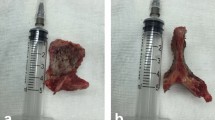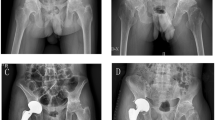Abstract
Purposes
We investigated sequential levels of C-reactive protein (CRP) and erythrocyte sedimentation rate (ESR) in uncomplicated ACDF (anterior cervical discectomy and fusion) using allograft and DBM (demineralised bone matrix) for primary cervical spondylosis and/or disc herniation. To our knowledge, there has been no study to investigate the diagnostic value of CRP and ESR for postoperative infection in ACDF using allograft and DBM.
Methods
Blood samples of 85 patients, who underwent one- (n = 51) or two-level (n = 34) ACDF, were obtained and evaluated before surgery and on the first, third, fifth, seventh, 14th, 30th, and 90th postoperative days. No infection was found in any patient for at least one year follow-up period.
Results
Mean CRP value increased significantly on the first postoperative day and reached a peak on the third postoperative day. The peak level rapidly decreased but remained elevated on the fifth, seventh, and 14th postoperative days. Mean ESR value increased significantly and reached a peak on the third postoperative day. The peak level gradually decreased but remained elevated on the fifth and seventh postoperative days. One- and two-level ACDF exhibited similar postoperative changes in CRP and ESR values and no significant difference in mean levels of CRP and ESR throughout the follow-up periods.
Conclusions
This study demonstrates that uncomplicated ACDF using allograft and DBM showed significant abnormal values of CRP and ESR during the early postoperative period. This result suggests that abnormal values of CRP and ESR in the early postoperative period do not indicate acute postoperative infection after ACDF using allograft and DBM. Straying from the normal course, such as a second rise or a failure to decrease, of CRP and ESR is more important to signpost acute postoperative infection in ACDF using allograft and DBM.





Similar content being viewed by others
References
Carette S, Fehlings MG (2005) Clinical practice. Cervical radiculopathy. N Engl J Med 353:392–399
Albert TJ, Murrell SE (1999) Surgical management of cervical radiculopathy. J Am Acad Orthop Surg 7:368–376
Rao RD, Currier BL, Albert TJ, Bono CM, Marawar SV, Poelstra KA, Eck JC (2007) Degenerative cervical spondylosis: clinical syndromes, pathogenesis, and management. J Bone Joint Surg Am 89:1360–1378
Yue WM, Brodner W, Highland TR (2005) Long-term results after anterior cervical discectomy and fusion with allograft and plating: a 5- to 11-year radiologic and clinical follow-up study. Spine (Phila Pa 1976) 30:2138–2144
Martin GJ Jr, Haid RW Jr, MacMillan M, Rodts GE Jr, Berkman R (1999) Anterior cervical discectomy with freeze-dried fibula allograft. Overview of 317 cases and literature review. Spine (Phila Pa 1976) 24:852–858
Fountas KN, Kapsalaki EZ, Nikolakakos LG, Smisson HF, Johnston KW, Grigorian AA, Lee GP, Robinson JS Jr (2007) Anterior cervical discectomy and fusion associated complications. Spine (Phila Pa 1976) 32:2310–2317
Pitzen TR, Chrobok J, Stulik J, Ruffing S, Drumm J, Sova L, Kucera R, Vyskocil T, Steudel WI (2009) Implant complications, fusion, loss of lordosis, and outcome after anterior cervical plating with dynamic or rigid plates: two-year results of a multi-centric, randomized, controlled study. Spine (Phila Pa 1976) 34:641–646
Park JB, Cho YS, Riew KD (2005) Development of adjacent-level ossification in patients with an anterior cervical plate. J Bone Joint Surg Am 87:558–563
Sasso RC, Smucker JD, Hacker RJ, Heller JG (2007) Artificial disc versus fusion: a prospective, randomized study with 2-year follow-up on 99 patients. Spine (Phila Pa 1976) 32:2933–2940
Bassewitz HL, Fischgrund JS, Herkowitz HN (2000) Postoperative spine infections. Semin Spine Surg 12:203–211
Miller LE, Block JE (2011) Safety and effectiveness of bone allografts in anterior cervical discectomy and fusion surgery. Spine (Phila Pa 1976) 36:2045–2050
Murrey D, Janssen M, Delamarter R, Goldstein J, Zigler J, Darden B (2009) Results of the prospective, randomized, controlled multicenter food and drug administration investigational device exemption study of the ProDisc-C total disc replacement versus anterior discectomy and fusion for the treatment of 1-level symptomatic cervical disc disease. Spine J 9:275–286
Arrington ED, Smith WJ, Chambers HG, Bucknell AL, Davino NA (1996) Complications of iliac crest bone graft harvesting. Clin Orthop Relat Res 329:300–309
Schnee CL, Freese A, Weil RJ, Marcotte PJ (1997) Analysis of harvest morbidity and radiographic outcome using autograft for anterior cervical fusion. Spine (Phila Pa 1976) 22:2222–2227
Floyd T, Ohnmeiss D (2000) A meta-analysis of autograft versus allograft. Eur Spine J 9:398–403
An HS, Simpson JM, Glover JM, Stephany J (1995) Comparison between allograft plus demineralized bone matrix versus autograft in anterior cervical fusion. A prospective multicenter study. Spine 20:2211–2216
Haralampos TH, Dinopoulos, Giannoudis PV (2006) Safety and efficacy of use of demineralised bone matrix in orthopaedic and trauma surgery. Expert Opin Drug Saf 5:847–866
Khan SN, Fraser JF, Sandhu HS, Cammisa FP Jr, Girardi FP, Lane JM (2005) Use of osteopromotive growth factors, demineralized bone matrix, and ceramics to enhance spinal fusion. J Am Acad Orthop Surg 13:129–137
Cheng I, Oshtory R, Wildstein MS (2007) The role of osteobiologics in spinal deformity. Neurosurg Clin N Am 18:393–401
Park KK, Kim TK, Chang CB, Yoon SW, Park KU (2008) Normative temporal values of CRP and ESR in unilateral and staged bilateral TKA. Clin Orthop Relat Res 466:179–188
Carr WP (1983) The role of the laboratory in rheumatology. Acute-phase proteins. Clin Rheum Dis 9:227–239
Palosuo T, Husman T, Koistinen J, Aho K (1986) C-reactive protein in population samples. Acta Med Scand 220:175–179
Takahashi J, Ebara S, Kamimura M, Kinoshita T, Itoh H, Yuzawa Y, Sheena Y, Takaoka K (2001) Early-phase enhanced inflammatory reaction after spinal instrumentation surgery. Spine 26:1698–1704
Kang BU, Lee SH, Ahn Y, Choi WC, Choi YG (2010) Surgical site infection in spinal surgery: detection and management based on serial C-reactive protein measurements. J Neurosurg Spine 13:158–164
Thelander U, Larsson S (1992) Quantitation of C-reactive protein levels and erythrocyte sedimentation rate after spinal surgery. Spine 17:400–404
Mok JM, Pekmezci M, Piper SL et al (2008) Use of C-reactive protein after spinal surgery: comparison with erythrocyte sedimentation rate as predictor of early postoperative infectious complications. Spine 33:415–421
Meyer B, Schaller K, Rohde V, Hassler W (1995) The C-reactive protein for detection of early infections after lumbar microdiscectomy. Acta Neurochir (Wien) 136:145–150
Kock-Jensen C, Brandslund I, Søgaard I (1988) Lumbar disc surgery and variations in C-reactive protein, erythrocyte sedimentation rate and the complement split product C3d. Acta Neurochir (Wien) 90:42–44
Sasso RC, Garrido BJ (2008) Postoperative spinal wound infections. J Am Acad Orthop Surg 16:330–337
Author information
Authors and Affiliations
Corresponding author
Rights and permissions
About this article
Cite this article
Kong, CG., Kim, YY. & Park, JB. Postoperative changes of early-phase inflammatory indices after uncomplicated anterior cervical discectomy and fusion using allograft and demineralised bone matrix. International Orthopaedics (SICOT) 36, 2293–2297 (2012). https://doi.org/10.1007/s00264-012-1645-z
Received:
Accepted:
Published:
Issue Date:
DOI: https://doi.org/10.1007/s00264-012-1645-z




